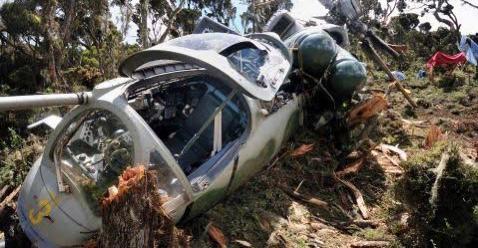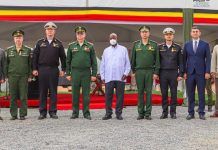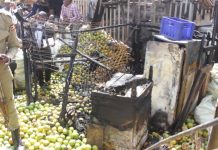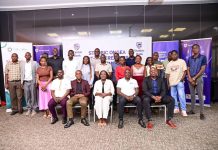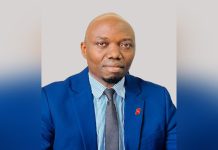By Faridah N Kulumba
Africa-Press – Uganda. Two Uganda People’s Defense Forces (UPDF) crashed in the eastern Democratic Republic of Congo (DRC) at the beginning of last week. The first clash happened on 24th near the village of Boga in Congo’s Ituri province and the other on 25 September 2022 in the border zone of Kabarole Uganda. The Mi-17 chopper was mainly used for transportation, medical evacuation, and VIP travel.
The fateful day
By the time the clash happened the helicopter had just delivered food consignment to the UPDF troops engaged in Operation Shujaa.
At the end of last year, Uganda’s UPDF and DR Congo army launched a joint operation against the Allied Democratic Forces (ADF), an armed group allied with Islamic State. Hundred of Ugandan soldiers and dozens of armored vehicles crossed the border at Nobili since the offensive started on November 30th. The joint forces conducted search operations in the forest of eastern Congo in an operation dubbed ‘Operation Shujaa.’
The ADF
The Allied Democratic Forces (ADF) began an uprising in DR Congo in the 1990s. It pledged allegiance to ISIL (ISIS) in mid-2019 and is accused of killing hundreds of villagers in frequent raids over the past years. Uganda blames the group for being behind many terrorist attacks in the country and the recent ones happened last year in November 2021 in which seven people including the bombers were killed.
Fatality
According to the army source who did not wish to be named at least 22 people were killed when the clash happened in east DRC. Another Congolese military source confirmed that three Congolese soldiers also died in the first clash. Among others who died was the instructor-cum-pilot named Ukrainian national Yury Vyshykvy, who died on the spot, while the Ugandan pilot Patrick Arinaitwe and five crew members sustained varied injuries.
What really happened?
According to the highly-placed security source, the crash was due to the tail rotor of the helicopter, which was technically on a captain-supervised flight, striking a tree, leading it to spin uncontrollably before crashing on troops collecting the delivered food. The tail rotor is an essential component that helps to neutralize the twisting momentum of the main propeller to keep a helicopter steady in flight, according to the United States Federal Aviation Administration (FAA).
President Museveni ordered investigations
It looks like the President of Uganda Yoweri Kaguta Museveni, who is the commander-in-chief of the armed forces, was skeptical about the two helicopter crashes explanations he, therefore, ordered a board of inquiry to investigate how and why military helicopters were dropping from the skies. The Uganda People Defence Air Force (UPDAF) Deputy Commander, Maj Gen Charles Okidi was tasked to lead the inquiries.
Is the investigations fear of a conspiracy?
It is not yet known whether there was a conspiracy because the investigations are still going on. But the army spokesman Brig Gen Felix Kulayigye explained about President Museveni ordering an investigation into the helicopter crash, saying that this is a normal procedure conducted whenever there is an accident, a board of inquiry is established to investigate the matter and that is why they put one in this incident.
Temporary stay
On 13 December 2021, the President of DR Congo Felix Tshisekedi announced that the Ugandan UPDF troop’s presence in his country was temporary. President Tshisekedi vowed to ensure that the presence of Ugandan troops in DRC, where they are fighting an Islamist militant group alongside Congolese forces, was strictly limited to the time strictly necessary for this operation.
In May this year, Uganda’s land forces commander Muhoozi Kainerugaba tweeted saying that Operation Shujaa was to officially cease in about 2 weeks according to the two nations’ original agreement, but until today UPDF is still there.
Change of schedule
In June, General Camille Bombele Lohola, the commander in charge of coordinating joint operations said they were given the mission to eradicate the ADF, but they have not yet managed to eradicate the enemy, and on that note, the joint operation is still on. Initially, Operation Shujaa was scheduled to last six months, which would have seen Uganda withdraw its troops in June 2022.
The ADF is among several militias wrangling over land resources in Congo’s mineral-rich east over the past decade, a conflict that has claimed thousands of lives and displaced millions.
Compensation
On 1st September, the government of Uganda started payment of the USD325 million (about Shs 1.23 trillion) compensation to the Democratic Republic of Congo (DRC). Uganda is trying to beat the deadline set by the International Court of Justice (ICJ).
In 1999, DR Congo petitioned the ICJ accusing Uganda’s armed forces of destroying properties, lives, and natural resources when it invaded the country in 1998. DR Congo had asked for a compensation of USD11bn but the judges dismissed several parts of the claim and decided on a far lower amount.
For More News And Analysis About Uganda Follow Africa-Press

